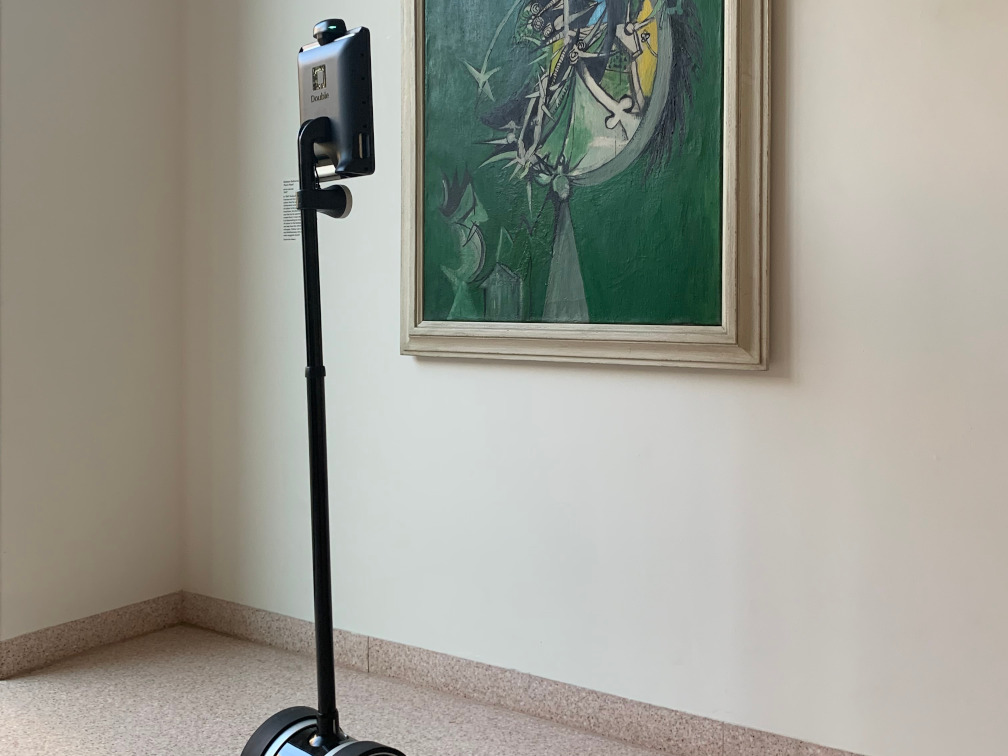One of the most iconic and much-loved British galleries of modern and contemporary art has responded to temporary closure due to the coronavirus by utilising robotics technology to provide its audiences with remote access to its exhibitions while its doors remain closed.
In a UK first, Hastings Contemporary, an independent charitable arts organisation, has teamed up with Bristol Robotics Lab to offer its members and audiences old and new alike the opportunity to continue to visit the gallery and experience the best of modern and contemporary arts via the Double, a two-wheeled videoconferencing robot that can guide an operator and up to five people through real time tours of the gallery and its current exhibitions, as well as taking in the gallery’s much-loved views over the historic Stade fishing beach and English Channel.
Praminda Caleb-Solly, Professor for Assistive Robotics and Intelligent Health Technologies at the Bristol Robotics Lab, UWE (the University of the West of England) said: “I am absolutely thrilled to team up with Hastings Contemporary as part of our Arts and Humanities Research Council D4D project to provide people who are socially isolated the opportunity to enjoy art via the telepresence robot.
“This is an excellent example of how robotics technology can be used to support people in difficult situations such as we are currently experiencing. There are other applications for use of telepresence robots within health and social care and I look forward to learning from our experiences at Hastings to apply elsewhere.”
Pioneering research
Esther Fox, Hastings Contemporary Trustee and Researcher on the D4D project, has said: “This has been made possible by a partnership with a pioneering research programme D4D, which explores how new technologies can change experiences of disability, social belonging and community engagement.
“Up until now we have been working with disabled people to explore how the telepresence robot might open up access to spaces they could not experience. We are now excited to see how we can enable a wider group of people to access great art and combat isolation, particularly those with underlying health conditions who are having to self-isolate.”
The telepresence robot, developed by Double Robotics, provides a revolutionary solution for arts organisations such as Hastings Contemporary in overcoming barriers of isolation. The gallery is delighted that through its adoption of this technology it will be able to continue to support families, children and older visitors alike, offering opportunities to enter the gallery space from the comfort of a sofa, bed or kitchen table.
The gallery is initially planning to offer robot-assisted guided tours of its current programme to visitors stuck at home, led by its curators and gallery team, as well applying the technology further to allow local artist-educators to facilitate interactive art lessons by piloting local children via the robot around the gallery.
Exploring social issues
The gallery’s experience using the telepresence robot will also help to deepen scientific knowledge and understanding of the technical, social and organisational issues regarding use of such technology and inform future research and development.
The gallery is planning, in addition, further ways to use innovative technologies to ‘flip’ the gallery inside out so that people can continue to benefit from its work while stuck at home, including developing a new online hub of art and mindfulness resources, with the children of key workers in mind, creating bespoke digital art lessons and creative learning activities for many of the now closed schools in Hastings; and virtual 3D renderings of its three postponed spring shows – Victor Pasmore: Line & Space; Stephen Chambers: The Court of Redonda, and Quentin Blake: We Live In Worrying Times.
Remote-controlled telepresence technology has not been used in a British gallery in this way before and Hastings Contemporary is delighted that it is able to create a radical and exciting alternative to the traditional gallery experience by harnessing the next generation of robotic hardware and empower both the gallery’s team and audiences during this testing time.
Pioneering continued engagement
Liz Gilmore, Director of Hastings Contemporary said: “As we navigate through these testing times and manage the loss of important revenue streams, I’m thrilled to embrace such innovation and creativity. Our trials with the telepresence robot have buoyed the team here in Hastings and will enable a new and pioneering means of continued engagement with our visitors.
“Next week I will be leading some virtual tours to bring to life the incredible exhibitions on offer, prioritising people who are most affected by the lockdown and are now having to self-isolate for a number of weeks. The Press will also be able to join in by appointment and recordings of these tours will be made available to the public afterwards.
“In this way, over the months ahead, we hope to continue our exciting future calendar of contemporary art exhibitions, and our educational and community engagement programmes.”
To visit the gallery and be one of the first people in the UK to experience this technology please email info@hastingscontemporary.org and visit https://www.hastingscontemporary.org/
Image Credits: Hastings Contemporary .



